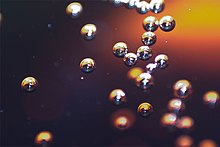Effervescence
This article needs additional citations for verification. (November 2021) |

Effervescence is the escape of gas from an
Effervescence can also be observed when opening a bottle of champagne, beer or carbonated beverages such as some carbonated soft drinks. The visible bubbles are produced by the escape from solution of the dissolved gas (which itself is not visible while dissolved in the liquid).
Chemistry
Although CO2 is most common for beverages, nitrogen gas is sometimes deliberately added to certain beers. The smaller bubble size creates a smoother beer head. Due to the poor solubility of nitrogen in beer, kegs or widgets are used for this.[2]
In the laboratory, a common example of effervescence is seen if
This process is generally represented by the following
In simple terms, it is the result of the chemical reaction occurring in the liquid which produces a gaseous product.[3]
See also
- Cavitation
- Carbonation
- Effervescent tablet
- Precipitation (chemistry), the "down-arrow"
References
- ^ "Effervescence". Archived from the original on 2007-06-09. Retrieved 2010-04-14.
- ISBN 9780854045884.
nitrogen gas beer
- ^ G. Liger-Belair et al., "Study of Effervescence in a Glass of Champagne: Frequencies of Bubble Formation, Growth Rates, and Velocities of Rising Bubbles", Am. J. Enol. Vitic. 50:3 (1999), 317–323.


